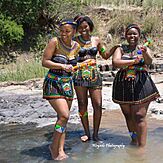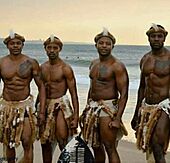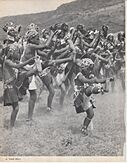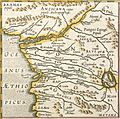Bantu people facts for kids
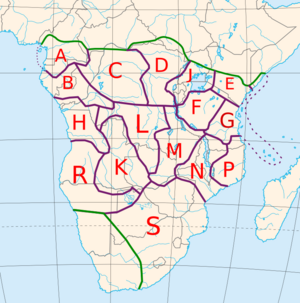
Approximate distribution of Bantu peoples divided into zones according to the Guthrie classification of Bantu languages
|
|
| Total population | |
|---|---|
| 350 million | |
| Regions with significant populations | |
|
|
| Languages | |
| Bantu languages (over 535) | |
| Religion | |
| Mostly Christianity (Catholic and Protestant) Minorities: Islam and traditional Bantu religions |
The Bantu peoples are a large group of about 400 different ethnic groups in Africa. They all speak languages that belong to the Bantu languages family. These languages are spoken across a huge area, from West Africa to Central, East, and Southern Africa. Some Bantu people also live in the southern parts of Northeast African countries.
There are hundreds of Bantu languages. Experts believe there are between 440 and 680 different languages, depending on how you define a "language" versus a "dialect." In the mid-2010s, about 350 million people spoke Bantu languages. This is about 30% of Africa's population! For example, in the Democratic Republic of the Congo alone, about 60 million people speak Bantu languages.
Some of the largest Bantu groups have populations of several million. These include the Baganda people in Uganda (about 5.5 million), the Shona in Zimbabwe (about 17.6 million), the Zulu in South Africa (about 14.2 million), and the Kikuyu in Kenya (about 8.1 million).
Contents
What Does "Bantu" Mean?
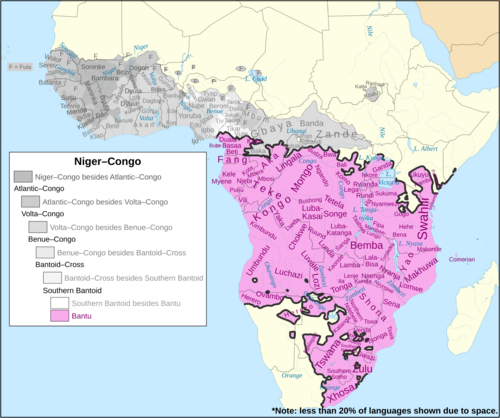
The word "Bantu" comes from a very old African word that means "people" or "humans." For example, in the Xhosa language and Zulu language, the word for "person" is umuntu, and the word for "people" is abantu.
The word "Bantu" was first used by a linguist (a language expert) named Wilhelm Bleek in the 1800s. He used it to describe the family of languages that share this common root word for "people."
Many Bantu languages have a similar word for "people." For instance, it's watu in Swahili, anthu in Chichewa, abantu in Kirundi and Luganda, and batho in Sesotho and Tswana. These words all show how connected these languages are.
History of Bantu Peoples
Where Did Bantu Peoples Come From?
The Bantu languages started from a very old language called Proto-Bantu. Experts believe this language was spoken about 4,000 to 3,000 years ago in West or Central Africa, in the area where Cameroon is today.
From there, Bantu-speaking people began to move and spread across Central, East, and Southern Africa. This movement is known as the Bantu expansion. It was a very fast spread that took about 2,000 years, from around 1000 BC to 1000 AD.
How Did Bantu Peoples Spread?
Scientists have studied the genes of over 2,000 people from 57 different groups across Africa. This helped them understand how Bantu populations moved. About 4,000 to 5,000 years ago, Bantu-speaking people started leaving their original homeland in West-Central Africa. They gradually traveled to the eastern and southern parts of the continent.
As Bantu-speaking people moved, they met other groups who were already living in those areas. Some of these groups, like the Pygmy peoples in Central Africa and the Khoisan people in Southern Africa, still exist today. However, many earlier inhabitants were displaced or joined the Bantu-speaking groups.
Early ideas about the Bantu expansion suggested two main paths: one moving east towards the African Great Lakes and another moving south along the African coast and the Congo River. Genetic studies show that Bantu speakers mixed with the local populations they met along their journey. For example, Bantu speakers in South Africa show signs of mixing with Khoisan people.
Bantu migrants also met other groups, like those who spoke Cushitic languages and Nilotic languages. They may have learned new things from these groups, such as how to keep cattle. The way Bantu people talk about cattle in their languages suggests they learned these practices from their neighbors.
Later Bantu Kingdoms
Between the 9th and 15th centuries, powerful Bantu-speaking kingdoms began to form in the Great Lakes region and in the savannas south of the Central African rainforests.
One famous example is the Monomotapa kings, who built the impressive Great Zimbabwe complex. This was a large city made of stone, and it was the center of a powerful civilization. Other similar sites in Southern Africa include Bumbusi and Manyikeni.
Over time, more and more Bantu states formed. This happened because populations grew, people started doing more specialized jobs (like being soldiers or craftspeople), and new technologies developed. Some of these important Bantu states included:
- The Kingdom of Kongo
- The Lunda Empire
- The Luba Empire
- The Zulu Kingdom
- The Kingdom of Rwanda
- The Swahili city states
On the East African coast, Bantu communities mixed with Muslim Arab and Persian traders. This led to the development of the Swahili culture, which has many Arab and Islamic influences. The Swahili language itself has many words borrowed from Arabic because of these interactions.
The Bantu migrations also reached Madagascar, an island off the coast of Africa. The Malagasy people of Madagascar have some Bantu ancestry, and their Malagasy language includes some Bantu words.
Bantu Groups by Country
| Country | Total population (millions, 2015 est.) |
% Bantu | Bantu population (millions, 2015 est.) |
Zones | Bantu groups |
|---|---|---|---|---|---|
| Democratic Republic of the Congo | 77 | 80% | 76 | B, C, D, H, J, K, L, M | Bakongo, Mongo, Baluba, numerous others |
| Tanzania | 51 | 95% | c. 45 | E, F, G, J, M, N, P | Abakuria, Sukuma, Nyamwezi, Haya, Chaga, Gogo, Makonde, Ngoni, Matumbi, numerous others |
| South Africa | 55 | 75% | 40 | S | Nguni (Zulu, Hlubi, Xhosa, Southern Ndebele, Swazi), Basotho (South Sotho), Bapedi (North Sotho), Venda, Batswana, Tsonga, Kgaga, numerous others |
| Kenya | 46 | 60% | 37 | E, J | Agikuyu, Abaluhya, ABASUBA, Akamba, Abagusii, Ameru, Abakuria, Aembu, Ambeere, Taita, Pokomo, Taveta and Mijikenda, numerous others |
| Mozambique | 28 | 99% | 28 | N, P, S | Makua, Sena, Shona (Ndau), Shangaan (Tsonga), Makonde, Yao, Swahili, Tonga, Chopi, Ngoni |
| Uganda | 37 | 80% | c. 25 | D, J | Baganda, Basoga, Bagwere, Banyoro, Banyankole, Bakiga, Batooro, Bamasaba, Basamia, Bakonjo, Baamba, Baruuli, Banyole, Bafumbira, Bagungu, numerous others |
| Angola | 26 | 97% | 25 | H, K, R | Ovimbundu, Ambundu, Bakongo, Bachokwe, Balunda, Ganguela, Ovambo, Herero, Xindonga, numerous others |
| Malawi | 16 | 99% | 16 | N | Chewa, Tumbuka, Yao, Lomwe, Sena, Tonga, Ngoni, Ngonde |
| Zambia | 15 | 99% | 15 | L, M, N | Nyanja-Chewa, Bemba, Tonga, Tumbuka, BaLunda, Balovale, Kaonde, Nkoya and Lozi, about 70 groups total. |
| Zimbabwe | 14 | 99% | 14 | S | Shona, Northern Ndebele, Bakalanga, numerous minor groups. |
| Rwanda | 11 | 76% | 11 | J | Banyarwanda |
| Burundi | 10 | 78% | 10 | J | Barundi |
| Cameroon | 22 | 30% | 6 | A | Bulu, Duala, Ewondo, Bafia Bassa, Bakoko, Barombi, Mbo, Subu, Bakwe, Oroko, Bafaw, Fang, Bekpak, Mbam speakers, numerous others |
| Republic of the Congo | 5 | 97% | 5 | B, C, H | Bakongo, Sangha, Mbochi, Bateke, Bandzabi, Bapunu, Bakuni, Bavili, Batsangui, Balari, Babémbé, Bayaka, Badondo, Bayaka, Bahumbu. |
| Botswana | 2.2 | 90% | 2.0 | R, S | Batswana, BaKalanga, Mayeyi, numerous others |
| Equatorial Guinea | 2.0 | 95% | 1.9 | A | Fang, Bubi, numerous others |
| Lesotho | 1.9 | 99% | 1.9 | S | Basotho |
| Gabon | 1.9 | 95% | 1.8 | B | Fang, Nzebi, Myene, Kota, Shira, Punu, Kande. |
| Namibia | 2.3 | 70% | 1.6 | K, R | Ovambo, Kavango, Herero, Himba, Mayeyi, numerous others |
| Eswatini | 1.1 | 99% | 1.1 | S | Swazi, Zulu, Tsonga |
| Somalia | 13.8 | <15% | <2.1 | E | Somali Bantu, Bajuni |
| Comoros | 0.8 | 99% | 0.8 | E, G | Comorian people |
| Sub-Saharan Africa | 970 | c. 37% | c. 360 |
"Bantu" in South Africa
In South Africa, the word "Bantu" has a complicated history. In the past, it was used by the government during apartheid (a system of racial segregation) to describe Black African people. Because of this, the word became linked to unfair and discriminatory policies.
Today, in South Africa, the word "Bantu" is mostly used in its original meaning, which is about language and linguistics. It is not used to describe people in a general way because of its past connection to apartheid.
Here are some examples of how "Bantu" was used in South Africa:
- A South African politician, General Bantubonke Harrington Holomisa, is known as Bantu Holomisa. His first name, Bantubonke, means "all the people."
- During apartheid, the government created areas called "bantustans." These were special areas meant for Black South Africans, but they were not truly independent. The name "bantustan" was used to make them sound like separate countries.
- The idea of ubuntu is very important in many South African cultures. It means "humanity" or "humaneness." This word comes from the same root as "Bantu." For example, in Xhosa and Zulu, the word for "humanity" is ubuntu.
- An early newspaper of the African National Congress (a political party) was called Abantu-Batho. This name combines the words for "people" from different Bantu languages.
Images for kids
-
The Bantu Kingdom of Kongo, c. 1630
See also
 In Spanish: Bantú para niños
In Spanish: Bantú para niños
- African Pygmies
- Bantu mythology
- Bantu music
- Demographics of Africa
- History of West Africa
- Khoisan
- Languages of Africa
- List of ethnic groups of Africa


